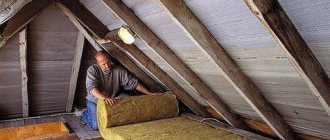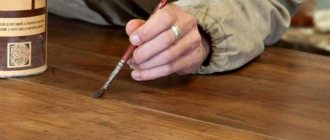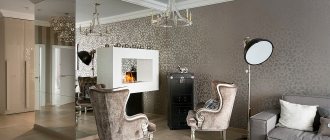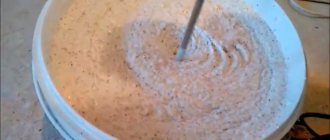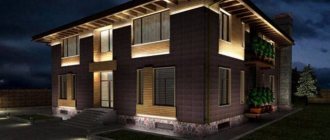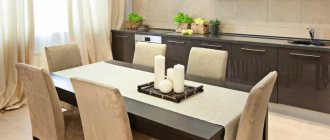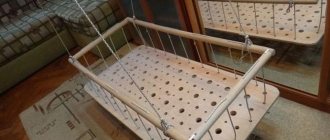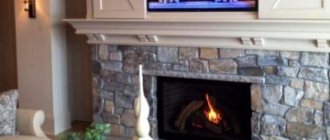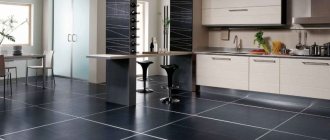Advantages of PVC panels
Wall decoration with decorative plastic has many advantages from a consumer point of view. Long service life, absolute moisture resistance in the plane, at joints, resistance to negative atmospheric influences, strength, other high technical characteristics of plastic (PVC) panels:
- The use of this type of finishing materials guarantees the customer quick, high-quality repairs that do not require significant financial costs.
- The cladding surface has high decorative properties and looks modern and aesthetically pleasing.
- When finishing, no preliminary preparation or leveling of walls and ceilings is required. The material effectively hides unevenness and other defects in supporting structures.
- Any composition of walls and ceilings is suitable for cladding: wood, brick, concrete, etc.
- Convenient to install electrical wiring.
- The products have high sound insulation properties. This is a great solution for anyone with noisy neighbors.
- They can withstand temperature changes and can be used in unheated rooms.
- They have the property of self-extinguishing, i.e. do not support combustion.
- Environmentally friendly.
These modern finishing materials are easy to use. The housewife will not need much effort to clean a room lined with PVC products. To remove dust and dirt, simply wipe them with a damp sponge using household detergents. Plastic is completely waterproof and does not rot. This useful property makes the material especially indispensable for finishing “wet” rooms: bathrooms, swimming pools, showers, bathrooms, loggias, balconies.
Plastic cladding allows you to minimize the amount of “dirty” repair and finishing work. By using this convenient material, you will avoid construction dust and dirt indoors.
How to choose quality panels
It is important that the plastic panels look beautiful on the wall and installation is carried out without any difficulties. The place of purchase also matters: in the market there is a greater chance that you will be handed a craft or rewarded with rejection. Specialized stores selling building materials have a much larger selection of colors, and they monitor quality more strictly, since they value their reputation.
All this can be directly checked when purchasing plastic panels: • There are no black dots on the painted side of a “quality” panel, the coloring is uniform without obvious differences. • Choose a panel that is even across its entire width, without waves or drops. It is easier to join with other panels, and it looks better on the wall than an uneven one. Small unevenness along the length of the panel is quite acceptable; when attached to the sheathing (wall), the panel will straighten. When connecting two even panels, you will get an unnoticeable and neat joint along the entire length. • The PVC panel must be free of physical defects on the front side: no holes, chips, or dents. In addition, the manufacturer plays a significant role - for example: how many years has the manufacturer been producing panels, how wide the choice of colors is.
Technical characteristics of PVC panels
The service life of products for the conditions of our climatic region is more than 10 years. Currently, manufacturers offer products with different operating temperature ranges. Thus, some types of products allow use in the temperature range from – 30 to +80 ° C.
There are a variety of finishing options for the front plastic surface. The thermal printing method allows you to obtain many different images that are resistant to fading from sunlight, giving the cladding surface high decorative properties. The protective varnish coating makes the product resistant to abrasion, prevents scratches, and makes it easy to clean from dirt.
Types of vinyl panels
Any finishing material can be produced in various modifications; polyvinyl chloride panels are no exception in this case.
The main division into types occurs depending on the area of application. In accordance with this rule, PVC panels can be intended for finishing ceilings or walls. The panels also differ in size. Modern manufacturers produce non-flammable plastic in widths of 12.5 cm, 25 and 38 cm. The thickness of the plastic determines the bending strength, so PVC wall panels are produced in thicknesses of 10 and 12 mm, and ceiling plastic can have a thickness of 6, 8 and 10 mm.
Table. Standard sizes of PVC panels
| Product type | Standard width, m | Standard length, m |
| Slatted panel | 0,13-0,3 | 0,9-3 |
| Wall panel | 0,15-0,5 | 2,6/2,7/3 |
| Tile panel | 0,3/0,98 | 0,3/0,98 |
| Sheet panel | 0,5-1,22 | 0,98-2,44 |
There is a separate group - laminated polyvinyl chloride panels. This material is particularly durable and resistant to mechanical damage. The design on such products retains its original appearance for a long time.
Application area
PVC panels have a wide range of applications. The frost resistance of the products allows them to be used for finishing balconies, loggias, open verandas, etc. Moisture resistance, resistance to rotting - properties useful for “wet” rooms - showers, bathrooms, swimming pools, basements, as well as for window and door slopes. Ease of maintenance makes PVC indispensable for finishing work areas with a high probability of contamination. Offices, shopping centers, sports facilities – the lightweight, practical material will find application everywhere.
Dimensions
Stone effect wall panels
Construction stores offer a wide range of PVC panels in different sizes and colors. They are all made according to the same principle. But in order to visually present them in the interior, it is recommended to visit exhibitions and not ignore the showroom in construction stores. There is a wide range of panels available, differing in their sizes; they can be in the form of PVC sheet panels or rectangular or even square.
Main panel sizes
| Width (mm) | Length (mm) | Thickness (mm) | Panel type |
| 250 | 2700 | 8 | leafy |
| 250 | 2700 | 9 | leafy |
| 100 | 2700 | 3 | leafy |
| 250 | 3000 | 7 | leafy |
| 375 | 6000 | 3 | leafy |
| 950 | 480 | 3 | rectangular |
| 950 | 650 | 8 | rectangular |
| 300 | 300 | 3 | square |
| 980 | 980 | 8 | square |
It is worth noting that sheet panels are more flexible, elastic, soft and pliable in work; this is an indispensable material for performing arch work, which greatly simplifies repairs, since all this can be done with your own hands. To give the panel the desired bend, sheet panels for interior decoration are required. It is worth choosing a plastic material, the width of which is small and the thickness is thinner than that of rectangular models of PVC panels. The panel should be placed in a warm room for 10-12 hours, in close proximity to a heat source. Due to the thin plastic, with slight heating, the material can be easily bent into an arched string.
The average thickness of a PVC sheet panel is 4-8 mm, but to create a bend it is better to give preference to panels with a thinner thickness. Due to their flexibility, sheet wall panels for interior decoration have become a godsend when sheathing curves. Of course, only an experienced specialist in this field can tell you how to cover an arched opening with PVC panels and how to bend a large panel correctly without damaging it.
PVC sheet panels
Square PVC panels
The height of the ceiling dictates what types of panels should be chosen. Sheet panels are indispensable for covering rooms with high ceilings. Often the length of the panel allows it to lie as a single, even sheet from ceiling to floor. When carrying out renovations in small rooms, for example, when covering bathrooms with PVC panels, you should give preference to rectangular or square models. There will be much less material waste, and the work will be easier.
Rectangular PVC panels
The range of panels in the construction industry is striking in its scale. These can be MDF or PVC panels, wooden panels. Each of them has its own technical characteristics, thanks to which the consumer makes a choice in favor of one or another model. Modern materials used in the production of PVC panels do not emit any odor at all, they come in different sizes, wider and narrower, with very small sizes for creating individual compositions. Panels for interior wall decoration can be made from thin and soft plastic that does not smell at all. But the biggest factor influencing the choice is the price, which sometimes differs significantly depending on the type of panel.
Parameters of plastic panels:
Designer:
- Color . Everything here is purely individual and without any recommendations. But as a rule, if difficulties arise with choosing a color, then white panels are purchased. White and black are universal colors and go well with any other.
- Drawing. If the plastic panels have a pattern, then this pattern imitates some material or pattern. Almost always it is marble, granite, sections of rocks, but imitation of mats, fabric, as well as wood, leather, or an ornamental pattern are also possible. The more contrasting and multi-colored the pattern, the stronger the effect on the nervous system. In addition, sometimes it may be difficult to select a pattern; in this case, panels need to be purchased with a good margin for cutting.
- Gloss level. Plastic panels can be matte, glossy, semi-gloss. There is no difference between them other than design preference. To obtain gloss, a lamination layer is applied to the front surface of the panels.
Operational and design:
- Surface texture. As a rule, plastic panels have a smooth surface. But on expensive panels with a pattern that imitates natural materials, the surface may be slightly embossed. On the one hand, this brings the appearance of the panel as close as possible to natural material, on the other hand, it is more difficult to care for such panels and therefore, in my opinion, it is not rational to cover the walls in the bathroom and kitchen with such panels, but again, there are no comrades according to taste and color.
- Durability. Of course, strength and plastic panels are poorly compatible concepts. It's easy to damage plastic panels. I think everyone has seen the disastrous results of using plastic panels for wall decoration in public places. However, the thicker the walls and partitions (stiffeners) of the panel, the stronger it is, although recently the thickness of the walls and stiffeners has only been decreasing.
- Chemical resistance. Any plastic panels can easily withstand treatment with modern detergents, but it is better not to take risks and use detergents with a minimum content of chemically active components.
Quality:
In addition to the fact that the panels may be “misbehaved,” the front surface of the panels may have scratches, dents, cuts, permanent stains, poor-quality lamination layer and other defects that are quite easy to see after unpacking the panels. It’s better to do this right in the store, so as not to take the panels back later and not quarrel with the sellers.
Due to the nature of the bathroom, few finishing materials can be used when renovating this room. But if earlier it was only ceramic tiles, now the latest developments in this area allow you to have a larger selection of materials that will help you realize any of your fantasies. And as an example, we will look at the use of plastic panels for the bathroom. They are also called PVC panels.
Today, they confidently occupy second place after tiles, since they have undoubted advantages, which we will discuss below, and also allow you to quickly and efficiently decorate a bathroom at minimal cost. Even if you are not a professional in this matter, you can completely cope with all the work yourself.
In addition, in any hardware store you will find a large assortment of plastic sheet panels that imitate not only all kinds of textures, but also a wide color palette and patterns. This allows the use of plastic panels in any room, regardless of its size, although designers recommend using light shades in small bathrooms to make it visually larger.
Plastic panels for bathroom
When purchasing plastic sheet panels, try to carefully inspect them so that they have as few protrusions and cracks as possible, since in the future moisture will accumulate in these places, which will lead to the growth of mold and mildew, not to mention dark spots that are unlikely to decorate your bathroom. And if you still want to combine tiles and ceramics, then plastic sheet panels for tiles are suitable for you.
Flammability index
One of the criteria for determining the quality and safety of any finishing or building material is the fire hazard class. It depends on several indicators, including flammability (G), flammability of the material (B), its smoke-forming ability (D) and toxicity of combustion products (T). The ability of PVC plastic to spread flame over the surface is also taken into account.
Non-flammable panels made of polyvinyl chloride must undergo testing, which results in a fire safety certificate. According to this document, PVC panels belong to the fire safety class KM3 with the corresponding parameters: G-2, V-2, D-3, T-2. That is, in fact, they are still moderately flammable (G2), they cannot be called completely non-flammable.
Polyvinyl chloride can be called a self-extinguishing material, since it stops burning without exposure to open flame. However, it does not tolerate high temperatures well, as a result of which the plastic begins to melt and emit a lot of smoke and harmful substances.
With constant exposure to flame, PVC begins to ignite at 391 ℃, and for combustion to continue, the temperature must increase by another 63°.
In accordance with the fire safety certificate, restrictions on use are imposed on products made of polyvinyl chloride.
It is not recommended to finish PVC ceiling and wall panels in medical and children's educational institutions, cinemas and concert halls, train stations and some enterprises engaged in serving the population.
It is prohibited to use plastic products to decorate escape routes and adjacent premises.
Characteristic advantages and disadvantages of plastic panels
Like any material, plastic panels have their advantages and disadvantages. Let's start with the positives.
According to manufacturers, all plastic panels are environmentally friendly, do not burn, have soundproofing properties, are lightweight, have good moisture resistance, durability, are easy to clean and, moreover, are inexpensive.
The disadvantages of plastic panels are as follows:
- low strength, scratches, dents and chips remain on the surface (one sufficiently strong blow or strong pressure leads to a crack); panels have a limited scope of application; initially there is a specific smell; Being a universal material, plastic panels are usually used for interior decoration.
